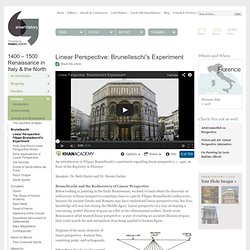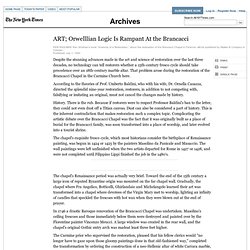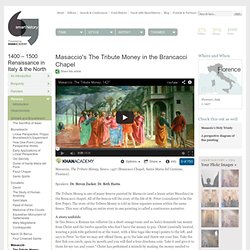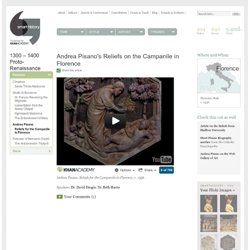

Convent of San Marco. The present convent stands on a site occupied since the 12th century by a Vallombrosan monastery which later passed to the Silvestrines; they were driven out of San Marco in 1418, and in 1438 the convent was given to the Dominican Observants.

In 1437 Cosimo il Vecchio de’ Medici decided to rebuild the entire complex, at the suggestion of Antonino Pierozzi the Vicar-General. The work was entrusted to Michelozzo, and the decoration of the walls was carried out between 1439 and 1444 by Giovanni of Fiesole, known as Fra Angelico, and his assistants, who included Benozzo Gozzoli. The church was consecrated in 1443 in the presence of Pope Eugenius IV. The 14th-century structure was modified by Michelozzo; further alterations were made in the later 16th century by Giambologna, and in 1678 by Pier Francesco Silvani. Inside, the aisle-less nave has a carved and gilded ceiling. Fra Angelico's The Annunciation. Your audio guides about Florence, download free audio book of Florence, Podcast for iPod or MP3, Italy guide. The Dome of Brunelleschi - Filippo Brunelleschi's Dome , Florence Italy.
The building of the dome on Florence cathedral, by Filippo Brunelleschi, can be considered one of the Renaissance's main building enterprises.

The highest expression of a new attitude, placing man and his abilities at the centre of the world and finding in classic antiquity the premises for cultural rebirth after the dark Middle Ages. Renaissance society was based on completely different values to the medieval ones of chivalry and nobility. The new ideals were self-sufficiency, civic virtue, intelligence and almost unlimited trust in man's abilities. Linear Perspective: Filippo Brunelleschi's Experiment. An introduction to Filippo Brunelleschi's experiment regarding linear perspective, c. 1420, in front of the Baptistry in Florence Speakers: Dr.

Beth Harris and Dr. Steven Zucker Brunelleschi and the Rediscovery of Linear Perspective Before looking at painting in the Early Renaissance, we need to learn about the discovery or rediscovery of linear perspective sometime close to 1420 by Filippo Brunelleschi (rediscovery, because the ancient Greeks and Romans may have understood linear perspective too, but if so, knowledge of it was lost during the Middle Ages). Linear perspective is a way of creating a convincing, perfect illusion of space on a flat or two-dimensional surface. Church of Santa Maria Novella, Florence Italy.
Masaccio's Holy Trinity. BRANCACCI CHAPEL. Robert Fulford's column about art restoration in Italy. (Globe and Mail, February 11, 1998) Rome Burrowing through the records of Renaissance churches a few years ago, a scholar came upon a striking fact: in the year 1516, the Brancacci Chapel in Florence burned half a barrel of oil every day, just to keep its votive lamps flickering.

The oil of course produced soot, which floated upwards and coated the art on the walls. Multiply that half-barrel by the days of the year, multiply again by the number of years this practice was followed (say, 400), then factor in the wax from candles lit by individual worshippers. When you think of it that way, there's no reason to wonder why Renaissance art looks pretty gloomy in its original settings. An English scholar, John Pope-Hennessy, wrote once that "great art is immutable. " All that oil burning in the Brancacci Chapel darkened Tommaso Masaccio's "Adam and Eve: The Expulsion," a crucial fresco that helped push art from Gothic to Renaissance. ART; Orwelllian Logic Is Rampant At the Brancacci. KEN SHULMAN; Ken Shulman's book ''Anatomy of a Restoration,'' about the restoration of the Brancacci Chapel in Florence, will be published by Walker & Company in October.Published: July 1, 1990 Despite the stunning advances made in the art and science of restoration over the last three decades, no technology can tell restorers whether a 15th-century fresco cycle should take precedence over an 18th-century marble altar.

Masaccio. Masaccio, The Tribute Money, fresco, 1427 (Brancacci Chapel, Santa Maria del Carmine, Florence) Speakers: Dr.

Steven Zucker, Dr. Beth Harris The Tribute Money is one of many frescos painted by Masaccio (and a lesser artist Masolino) in the Brancacci chapel. All of the frescos tell the story of the life of St. A story unfolds In this fresco, a Roman tax collector (in a short orange tunic and no halo) demands tax money from Christ and the twelve apostles who don't have the money to pay. Andrea Pisano's Reliefs on the Campanile in Florence. About Executive Editors Awards & Conferences Contributors Create & Teach All Videos Blog Time Ancient Cultures Medieval Era Proto-Renaissance.

Uffizi, Uffizi gallery, Florence. Cimabue, Santa Trinita Madonna. Giotto, The Ognissanti Madonna. The Uffizi Gallery (Galleria degli Uffizi), Florence Italy.